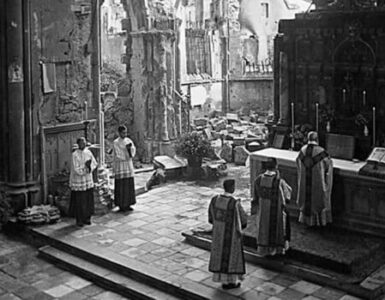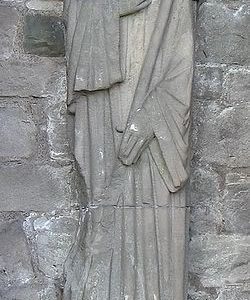Dear Father Kerper: Someone told me that December 25 is definitely not the birthday of Jesus Christ. Was Christ born on Christmas or not? If not, why has the Church always claimed that Jesus was born on December 25? And how could people get so mixed up about something so important?
Before answering your question, we need to consider our contemporary understanding of birthdays and how it differs from that of the early Church. In our culture, we heavily emphasize “marking” the precise anniversary of everyone’s birthdate. By doing this we remember and rejoice over the entire life of the person, not just his or her actual birth. For example, when we celebrate the birthday of Washington, Lincoln, or some other heroic person, we ponder his whole life, not just his or her actual birth.
Early Christians had a very different approach. Indeed, they did not like birthdays at all because such festivals were intertwined with the “old religions,” which dabbled in astrology and the occult.
To distance themselves from old pagan practices, early Christians tended to celebrate the day of a person’s death as his or her true birthday. This reflected the Christian belief that a person’s physical birth mattered very little unless it culminated in eternal life, which begins at death. A holy death — not mere birth — deserves great celebration.
In keeping with this approach, Christians began to link the feasts of saints with the anniversaries of their deaths, never with their birthday, except for Mary, the Mother of the Lord (September 8) and Saint John the Baptist (June 24).
This brings us to your question: Is December 25 the real birthday of Christ? Yes, if you mean the day on which Christians have celebrated the Lord’s birth almost universally from the earliest times. However, the Church has never definitively taught that Jesus was born on December 25; there is no conclusive documentary evidence, and Sacred Scripture mentions no date whatsoever.

This lack of evidence should not surprise us in the least. While we place great value on keeping precise records of births, deaths, and marriages, ancient people did not, especially among common people such as Jesus, Mary, and Joseph. Most people in Palestine probably had no idea of their exact birthdates, and illiterate parents had no way of keeping track of their children’s birthdays. While they may have remembered the season of the child’s birth, they probably forgot the day and even the year.
As to Christ, we must always remember that the Gospels were “written in reverse” — they begin with the final events of Christ’s life: His Passion, death, and Resurrection. The familiar Christmas texts of Saint Matthew and Saint Luke were all written after the Passion accounts. Moreover, if these Christmas stories, which we love so much, had never been written or had been lost, nothing of our faith in Christ would change. After all, the Gospels of Saint Mark and Saint John say nothing at all about the birth of Jesus. For sure, the Christmas texts deepen our understanding of Christ and provide wonderful color to the story, but they are not essential. Hence, we do not really need to know the date of Christ’s birth.
Now, let us turn to long-established belief that December 25 is indeed the birthday of Christ. The choice of this date was no mere accident or whim. It has a strong theological basis.
By about AD 360 (or even earlier), Roman Christians had begun to celebrate the birth of Christ on December 25. However, Christians in other regions had fixed his birthday on January 6 (in conjunction with the Epiphany). Others had it on April 20 and May 15. Gradually, however, December 25 became almost universal. If Jesus has no birth certificate, why pick December 25? Because of its proximity to the winter solstice, nature’s turning point between light and darkness.
Some ancient theologians believed that the events of Christ’s life were mysteriously synchronized with the movements of nature. The following text from Saint Augustine is a good example of such thought:
Let us rejoice, my brothers! A happy day it is for us as well as for the nations of the world!
This particular day [December 25] has been made special not by the sun we see but by its Creator, whom we can’t see. When did this happen? When a Virgin Mother poured forth from her fertility, without the aid of her genitalia, Him whom we could see. All that was made possible by her Creator, whom we can’t see.
Later, Saint Augustine says:
It’s as good a day as any. The Winter Solstice. Fall changing into winter. The shortest day. With each succeeding day, the light becomes longer—Couldn’t this signify the work of Christ?
Saint Augustine and other Doctors of the Church derived the exact birthday of Jesus through classical theological reflection, not through Sacred Scripture. While the speculations of holy theologians such as Saint Augustine are certainly worthy of belief, they are not definitive.
Finally, there is another reason for December 25: The “old” Roman religion also proposed a relationship between nature and its own gods. Hence, Romans celebrated a feast called Natalis Solis Invincti, which rejoiced over the “rebirth” of the sun at the winter solstice. Many scholars have asserted that Christians simply baptized this old pagan festival, replacing the sun with the Son of God.
In terms of worship and prayer, Christmas Day — December 25 — is the only universal focal point of Christians as they rejoice in the birth of Christ, the One who would suffer, die, and rise again. By celebrating the Lord’s birthday on December 25, we unite ourselves with hundreds of believing generations spread over many centuries. Surely, the Lord must now regard December 25 as His only true birthday, for on that day alone millions say, “Happy Birthday!”
The True Story of Saint Nicholas
Many people learn fairy tales and Bible stories simultaneously during early childhood. As a result, when the fairy tales dissolve as a child matures, the stories about Jesus can also lose their credibility. Amid this jumble of childhood stories, one must distinguish between fanciful fabrications and truths rooted in history.
Let’s begin with Santa Claus. We know for certain that a man named Nicholas was born in Asia Minor (modern-day Turkey), served as bishop of Myra, died around 350, and soon became honored as a great saint. Although we lack precise historical documentation, it’s highly probable that he assisted the poor, healed the sick, and interceded with God for people in need. Over time, stories about the kindness and generosity of Nicholas spread throughout Europe and other parts of the world.
Gradually, Nicholas of Myra evolved into the figure now known as Santa Claus, a name derived from the Latin word sancta (saint) and the last part of the name Nicholas. Strictly speaking, then, Santa Claus/Saint Nicholas did indeed exist. He is not at all like the tooth fairy and the Easter Bunny.
In a sense, Santa Claus/Saint Nicholas acts in the world today whenever people imitate, even unconsciously, his goodness and generosity by giving gifts to others, especially children. After all, every loving deed somehow originates in God, who is love, and when someone like Saint Nicholas inspires gift giving, we can say that he somehow truly shares in the act.
Now we come to the Christmas story, which you learned as a child alongside the Santa Claus story. At first glance it seems to be the same thing: a story with a genuine historical root but overlaid with untrue and fanciful details. But the Christmas story, at least the parts recounted in Sacred Scripture, differs fundamentally from fairy tales such as the full-blown Santa story.
First, Christmas commemorates a true historical fact: the birth of Jesus of Nazareth, the one acclaimed by many as Messiah and Son of God. Today, there’s no serious historian — whether believer or unbeliever — who would challenge His existence. The documentation, although sparse, is persuasive.
In addition to reporting the birth of Jesus, the Gospel writers included many secondary details, such as the star of Bethlehem, shepherds, magi, angels, and so forth. These well-known elements go far beyond “raw history” by asserting truths of faith about Jesus, such as His true familial link with King David, His life and death as ultimate fulfillment of Israelite prophecy, and His mission to the Gentiles.
These elements of the biblical Christmas story differ from the fanciful stories about Santa Claus. Consider the famous poem “The Night before Christmas,” written by Clement Clarke Moore in 1822. Moore wrote his poem to entertain and delight young children. His charming description of Santa’s nocturnal visits on Christmas Eve is entirely fictional and unrelated to the historical Saint Nicholas. By contrast, the biblical Christmas story is not entertainment for children, but an essential part of Sacred Scripture that expresses basic truths about Christ’s origin and identity.
I hasten to add that much traditional imagery associated with the Christmas story goes far beyond what the Gospels state. Figures in nativity scenes such as the little drummer boy, talking mice, and the kneeling Santa are all innovations, not part of the biblical account. Although cute, they can confuse children by mixing the fanciful with the biblical.
As the Christmas season approaches I hope this explanation will help you to rediscover the essential truth we celebrate: that God, who is love, sent His Son to us, and that everyone who is joined to Him — including Santa Claus/Saint Nicholas, your parents, and you — can extend divine love into the world.
✠
Editor’s note: This article is from a chapter in Fr. Kerper’s A Priest Answers 27 Questions You Never Thought to Ask, which is available through Sophia Institute Press.
Photo by Shalone Cason on Unsplash












